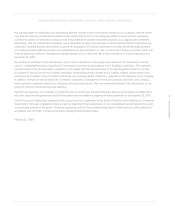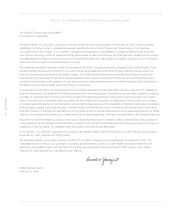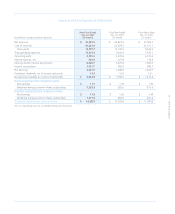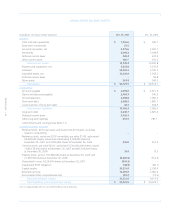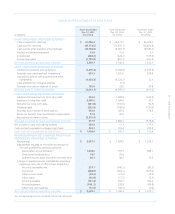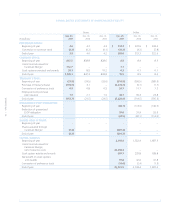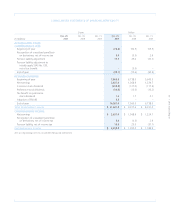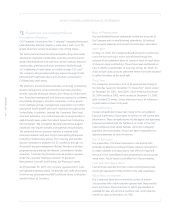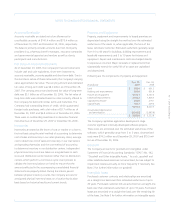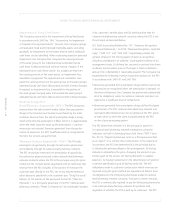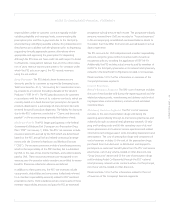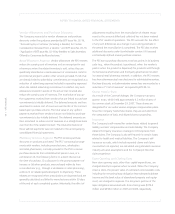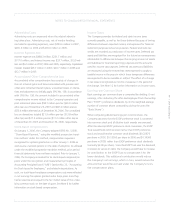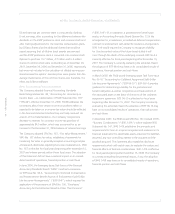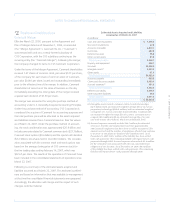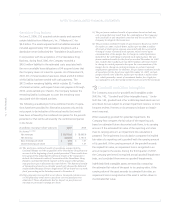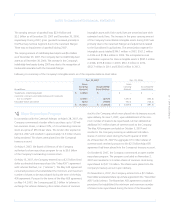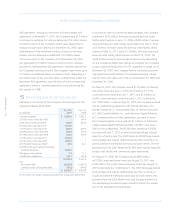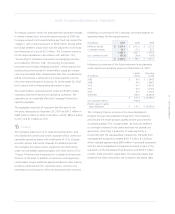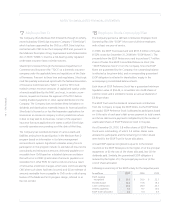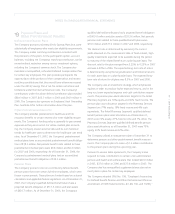CVS 2007 Annual Report Download - page 51
Download and view the complete annual report
Please find page 51 of the 2007 CVS annual report below. You can navigate through the pages in the report by either clicking on the pages listed below, or by using the keyword search tool below to find specific information within the annual report.
47 I 2007 Annual Report
responsibilities under its customer contracts typically include
validating eligibility and coverage levels, communicating the
prescription price and the co-payments due to the third party
retail pharmacy, identifying possible adverse drug interactions for
the pharmacist to address with the physician prior to dispensing,
suggesting clinically appropriate generic alternatives where
appropriate and approving the prescription for dispensing.
Although the PSS does not have credit risk with respect to Retail
Co-Payments, management believes that all of the other indica-
tors of gross revenue reporting are present. For contracts under
which the PSS acts as an agent, the PSS records revenues
using the net method.
Drug Discounts. The PSS deducts from its revenues any
discounts paid to its customers as required by Emerging Issues
Task Force Issue No. 01-9, “Accounting for Consideration Given
by a Vendor to a Customer (Including a Reseller of the Vendor’s
Products)” (“EITF 01-9”). The PSS pays discounts to its customers
in accordance with the terms of its customer contracts, which are
normally based on a fixed discount per prescription for specific
products dispensed or a percentage of manufacturer discounts
received for specific products dispensed. The liability for discounts
due to the PSS’ customers is included in “Claims and discounts
payable” in the accompanying consolidated balance sheets.
Medicare Part D. The PSS began participating in the Federal
Government’s Medicare Part D program as a Prescription Drug
Plan (“PDP”) on January 1, 2006. The PSS’ net revenues include
insurance premiums earned by the PDP, which are determined
based on the PSS’ annual bid and related contractual arrange-
ments with the Centers for Medicare and Medicaid Services
(“CMS”). The insurance premiums include a beneficiary premium,
which is the responsibility of the PDP member, but is subsidized
by CMS in the case of low-income members, and a direct subsidy
paid by CMS. These insurance premiums are recognized in net
revenues over the period in which members are entitled to receive
benefits. Premiums collected in advance are deferred.
In addition to these premiums, the PSS’ net revenues include
co-payments, deductibles and coinsurance (collectively referred
to as member responsibility amounts) related to PDP members’
prescription claims. CMS subsidizes certain components of these
member responsibility amounts and pays the PSS an estimated
prospective subsidy amount each month. The prospective subsidy
amounts received from CMS are recorded in “Accrued expenses”
in the accompanying consolidated condensed balance sheets to
the extent that they differ from amounts earned based on actual
claims experience.
The PSS accounts for CMS obligations and member responsibility
amounts using the gross method consistent with its revenue
recognition policies, including the application of EITF 99-19.
Additionally, the PSS includes actual amounts paid by members of
its PDP to the third party pharmacies in its national retail pharmacy
network in the total Retail Co-Payments included in net revenues.
Please see Note 13 for further information on revenues of the
Company’s business segments.
Cost of Revenues
Retail Pharmacy Segment. The RPS’ cost of revenues includes:
the cost of merchandise sold during the reporting period and the
related purchasing costs, warehousing and delivery costs (includ-
ing depreciation and amortization) and actual and estimated
inventory losses.
Pharmacy Services Segment. The PSS’ cost of revenues
includes: (i) the cost of prescription drugs sold during the
reporting period directly through its mail service pharmacies and
indirectly through its national retail pharmacy network, (ii) ship-
ping and handling costs and (iii) the operating costs of its mail
service pharmacies and customer service operations and related
information technology support costs (including depreciation and
amortization). The cost of prescription drugs sold component of
cost of revenues includes: (i) the cost of the prescription drugs
purchased from manufacturers or distributors and shipped to
participants in customers’ benefit plans from the PSS’ mail service
pharmacies, net of any volume-related or other discounts (see
“Drug Discounts” above) and (ii) the cost of prescription drugs
sold (including Retail Co-Payments) through the PSS’ national
retail pharmacy network under contracts where it is the principal,
net of any volume-related or other discounts.
Please see Note 13 for further information related to the cost
of revenues of the Company’s business segments.


